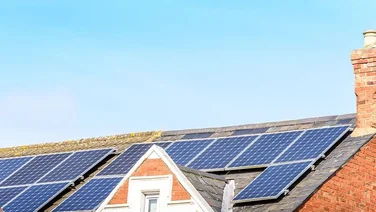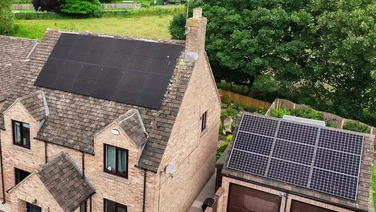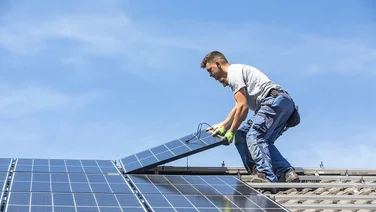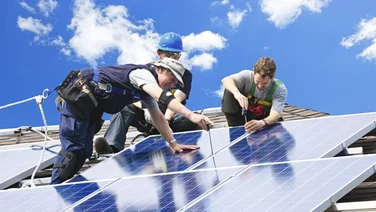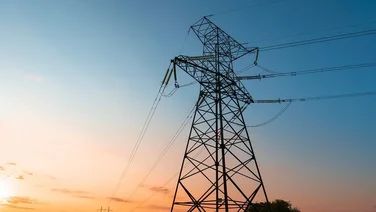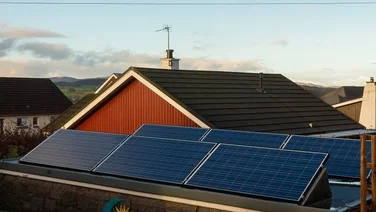- What does it mean to put your solar panels in series or parallel?
- Why would you put your solar panels in series?
- Why would you put your solar panels in parallel?
- How will putting your solar panels in series or parallel affect your savings?
- Are solar panels in the UK usually in series or parallel?
- Should you put your solar panels in series or parallel?
- Next steps
- Series connections produce more energy in ideal conditions
- Solar panels wired in parallel are better protected against obstructions
- Most solar panel systems feature both connections

As well as knowing the best angle and direction for solar panels, it’s important to know if solar panels should be in series or parallel.
On this page, we’ll explain what the difference is between series and parallel connections, the pros and cons of both, and why your installer may well recommend combining the two so you can start benefiting from free, clean electricity.
If you want to get your own solar installation, you can compare solar panel prices with our help. Just provide a few quick details, and our expert installers will be in touch with free quotes.
Where do you want to install solar panels?
Get startedWhat does it mean to put your solar panels in series or parallel?
Solar panels are wired to each other in two different ways: series and parallel.
Every solar panel has a negative and positive terminal, just like the batteries you use at home, and how they’re connected determines whether your system is in series or parallel.
A series connection is when the positive terminal of each panel is wired to the negative terminal of another. This increases the system’s overall voltage – and therefore its output – while keeping the amperage the same as one panel.
Parallel connections are the exact opposite – they involve connecting all the positive terminals to each other, and the negative terminals to each other. This will keep the system’s voltage low, while increasing its amperage.
A disruption in a series connection – for instance if something casts shade on your solar array – will cause every panel in the system to produce less energy.
On the flip side, panels in a parallel connection will continue to work independently of each other, no matter what happens to the rest of the system.
Let’s say you’ve put up a string of fairy lights. If one bulb unexpectedly goes out and they’re wired in parallel, the other lights will stay on – but if they’re in series, they’ll all go out.
It’s also relatively common to use a combination of series and parallel connections, to ensure your system reaches the highest voltage and amperage it can without overwhelming your inverter.
It’s crucial your installer makes the right choice between series, parallel, or both, as the way your panels are wired will have a massive impact on how much power the solar panels generate.
Why would you put your solar panels in series?
Pros | Cons |
|---|---|
Produces more energy than in parallel | Shade can severely affect output |
Makes the most of any and all daylight | |
Lower amperage means lighter, cheaper cables |
If there’s no risk of your solar panels being obstructed, you can increase the system’s output with a series connection.
The high voltage will usually result in a higher amount of solar energy being generated at all times of day, which means you can make the most of the low light available in the early morning or at dusk, as well as times when the sun is blazing.
Connecting your panels in series also allows your system to meet a powerful inverter’s voltage requirements – and if you’re in danger of exceeding the inverter’s limits, you can separately wire the extra panels in series, then link them in parallel.
However, all it takes is one errant breeze causing a poorly placed tree to throw shade over a single panel, and your output will drop dramatically.
Why would you put your solar panels in parallel?
Pros | Cons |
|---|---|
If one panel’s obstructed, the others will continue working normally | Produces more energy than in series |
Occasional shade won’t slash your output | Higher amperage means heavier, more expensive cables |
You can use a less powerful inverter |
If at least some of your solar panel system will often be in the shade, connecting your panels in parallel could be the answer.
If one of your panels is obstructed, parallel wiring ensures the other panels operate as usual.
A parallel connection also increases the amperage without raising the voltage, which is great if your inverter can’t handle a high voltage.
How will putting your solar panels in series or parallel affect your savings?
Putting your solar panels in series will generate more energy and save you more money, if your system is always unobstructed.
However, the entire equation changes if your panels are frequently thrown into shade.
Then you’ll want to wire your system in parallel, which will ensure all your non-shaded panels keep generating the same amount of energy.
Depending on how troublesome your shade problem is, the difference between a series and parallel connection can run to hundreds of pounds in savings.
Are solar panels in the UK usually in series or parallel?
The majority of solar panel systems use both series and parallel connections.
Your solar panel installer will usually recommend dividing your panels into two groups, wiring each group in series, then connecting them in parallel.
This is because most roofs are clear of overhead obstructions like trees, so you’re able to take advantage of the increased output that panels wired in series can produce.
The parallel connection between the two sets of panels is intended to protect you against any unforeseen issues, like an loft conversion on your neighbour’s house that means your panels are suddenly in shade for some of each day.
Using both series and parallel connections also means you can increase the voltage and amperage at the same time, allowing you to produce the most energy possible.
Should you put your solar panels in series or parallel?
Ideally, your installer will recommend putting your solar panels in series and parallel.
This will ensure you use the highest voltage and amperage possible with your inverter, and therefore generate the maximum amount of solar energy.
But if your panels will often be in shade, you may well want to put your solar panels in parallel instead.
Or if you aren’t getting many panels and they definitely won’t be in shade at any point, you may want to opt to wire them in series alone.
Next steps
You now have all the information you need to have an in-depth conversation with your installer about their decision to put your solar panels in series, in parallel, or both.
Ultimately though, you should primarily listen to your installer’s recommendation.
If you want to find a solar panel installer who can help you make the right choice for your home, the ideal first step is to get multiple quotes.
Kick-start this process with our free comparison tool. Just fill in a few details and our trusted suppliers will get in touch with free quotes.

